Carillon
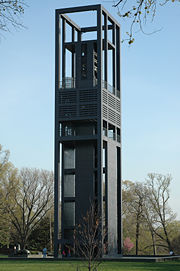
A carillon (/kaʁijɔ̃/, /ˈkærɪljɒn/ or /kəˈrɪljən/) is a musical instrument consisting of at least 23 cast bronze cup-shaped bells which are played one after the other (to play a melody) or sounded together (to play a chord). A carillon is played by striking a keyboard (called a "baton") with the fists and by pressing the keys of a pedal keyboard with the feet. The keys mechanically activate levers and wires that connect to the metal clappers that strike the bells, allowing the performer (known as a "carillonneur") to vary the intensity of the note according to the force applied to the key.
Carillon bells are usually housed in the bell towers of church towers, belfries, or in municipal buildings. The carillon is the heaviest of all musical instruments; the total weight of bells alone can be 100 tons in the largest instruments. The greatest concentration of carillons is still found in the Netherlands, Belgium, and Northern France, where they were symbols of civic pride and status. Some of the most spectacular are now protected by UNESCO as part of the world heritage site the Belfries of Belgium and France.
Contents |
History

In medieval times, bells were first used as a way of notifying people of fires, storms, wars and other events. The great bell Rowland announced births, deaths, fires, and military attacks. A ringing of bells rung from the lowest note to the highest note indicated that an attack had taken place. The use of bells in a musical fashion originated in the 14th century in the Low Countries.
In the 17th century, François and Pieter Hemony developed the art of bell-founding and -designing, and tuning, which they passed on to Antwerp bellfounder Melchior de Haze. In the 18th century, several members of the Van den Gheyn bellfounders dynasty also mastered the skill of bell tuning, such as Andreas Joseph Van den Gheyn. Unfortunately his techniques also passed away with him. It was not until the 19th century in England under the Taylor bellfoundry at Loughborough, England, that bell tuning was re-invented.
The greatest concentration of carillons is still found in The Netherlands, Belgium, and in (the North of) France, where they were mounted in the grand towers of rich cities as tokens of civic pride and status. Carillons were usually housed in church towers, belfries, or in municipal buildings. In Germany, a carillon is also called a Glockenspiel.
Musical characteristics
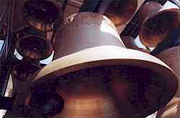
Since each separate note is produced by an individual bell, a carillon's musical range is determined by the number of bells it has. Different names are assigned to instruments based on the number of bells they comprise:
- Carillons with 23 through 27 bells are referred to as two-octave carillons. Players of these instruments often use music arranged specifically for their limited range of notes.
- The "keyboard" of a carillon is called a baton console.
- A concert carillon has a range of at least four octaves (47 bells). This is sometimes referred to as the "standard-sized" carillon.
- A five-octave, 61-bell carillon can be heard at the University of California, Santa Barbara in Storke Tower.
The Riverside Carillon in New York City has (or did have—there may be other instruments with larger bourdons) the largest tuned bell in the world, which sounds the C two octaves below middle C on the piano.
- Travelling or mobile carillons are not placed in a tower, but can be transported. Some of them can even be played indoor—in a concert hall or church—like the mobile carillon of Frank Steijns.
- Modern imitation instruments (such as those made by Schulmerich) use semantra (rectangular metal bars roughly the diameter of a pencil, but of varying lengths) struck by an electric solenoid. They may be played from a keyboard, organ console, or by means of music rolls. The resulting sound is electronically amplified and broadcast by loudspeakers. Although called "carillons" or "electronic carillons", their sound does not conform to the definitions given by the World Carillon Federation[1] or the Guild of Carillonneurs in North America[2]. The GCNA as of 2000 has disqualified all instruments in which more than 12 bells are played electrically. Twelve bells are allowed so that automatic chiming of tunes may take place. Chiming means that one bell at a time is usually played.
The carillonneur or carillonist is the title of the musician who plays the carillon. The carillonneur/carillonist usually sits in a cabin beneath the bells and presses down, with a loosely closed fist, on a series of baton-like keys arranged in the same pattern as a piano keyboard. The batons are almost never played with the fingers as one does a piano, though this is sometimes used as a special carillon playing technique. The keys activate levers and wires that connect directly to the bells' clappers; thus, as with a piano, the carillonneur can vary the intensity of the note according to the force applied to the key. In addition to the manual keys, the heavier bells are also played with a pedal keyboard. These notes can either be played with the hands or the feet.
To a musician's ear, a carillon can sound "out of tune." Poorly tuned bells often give this impression and also can be out of tune with themselves. This is due to the unusual harmonic characteristics of foundry bells, which have strong overtones above and below the fundamental frequency. Foundry bells are tuned to have the following set of partials (overtones):
- Octave above prime
- Fifth
- Minor third
- Prime and strike tone resultant
- Hum tone (an octave below prime)
Additionally, there is a major 10th, 12th, and 15th which are not typically individually tuned, but are usually present anyway. They all combine to create a "resultant" pitch, which is in unison with prime on a well-tuned bell. Properly tuned bells emphasize the fundamental frequency of the bell.
Music
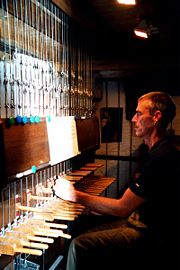
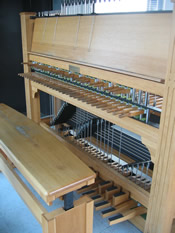
There is no standard pitch range for the carillon. In general, a concert carillon will have a minimum of forty-eight bells. The range of any given instrument usually depends on funds available for the fabrication and installation of the instrument: more money allows more bells to be cast, especially the larger, more costly ones. Older carillons can be transposing instruments, generally transposing upward. Most modern instruments sound at concert pitch. A carillon clavier has both a manual and a pedal keyboard.
Carillon music is typically written on two staves. Notes written in the bass clef are generally played by the feet. Notes written in the treble clef are played with the hands. Pedals range from the lowest note (the bourdon) and may continue up to two and half octaves. In the North American Standard keyboard, all notes can be played on the manual.
Because of the acoustic peculiarities of a carillon bell (the prominence of the minor third, and the lack of dampening of sound), music written for other instruments needs to be arranged specifically for the carillon. That said, music from all periods and styles of music can, with care, sound excellent on the carillon.
The combination of carillon and other instruments, while possible, is generally not a happy marriage. The carillon is generally far too loud to perform with most other concert instruments. The great exceptions to this are some late twentieth- and early twenty-first century compositions involving electronic media and carillon. In these compositions, sound amplification is able to match the extreme dynamic range of the carillon and, in the case of sensitive composers, even the most delicate effects are possible.
Recording the carillon is notoriously difficult. The extreme amount of sound waves that are generated and the layout of a carillon present problems not found in normal recording situations. The use of pzm microphones can handle the enormous waves of sound, but it isn't possible to decide on the location of the microphones without experimentation.
Musicians
- Jacob van Eyck (1590–1657) - The Netherlands
- Hans Uwe Hielscher (born 1945) - Germany
- Robert Grogan (born 1944) - United States of America
- Frank DellaPenna - United States of America
- Frank Steijns (born 1970) - The Netherlands
Media
Instruments by country
Overview of highest concentrations of carillons (as defined by the World Carillon Federation) (data September 2006):
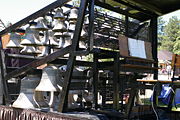
| Region | Surface area (km²) |
Number of carillons |
Concentration per 1000 km² |
|
|---|---|---|---|---|
| Netherlands | 41,526 | 182 | 4.383 | |
| Belgium | 30,528 | 89 | 2.915 | |
| Brussels-C. R. | 161 | 2 | 12.422[3] | |
| Flanders | 13,522 | 64 | 4.733 | |
| Wallonia | 16,844 | 23 | 1.365 | |
| Nord, France[4] | 5,743 | 15 | 2.612 | |
| Côte d'Or, France[5] | 8,763 | 5 | 0.571 | |
| for comparison only: | ||||
| USA | 9,631,420 | 164 | 0.017 | |
| Australia | 7,741,220 | 2 | 0.0003 | |
Schools
Carillon schools include the Netherlands Carillon School in the Netherlands and the first international school, the Royal Carillon School "Jef Denyn" in Mechelen, Belgium.
In North America, one can study the carillon at the University of California, Berkeley, the University of Michigan in Ann Arbor (which is home to two of only twenty-three grand carillons in the world), the University of Florida, the University of Denver's Lamont School of Music, and Missouri State University, all which offer complete courses of study. One can also take private lessons at many carillon locations, and there are universities that offer limited credit for carillon performance, such as Clemson University or Cornell University.
The George Cadbury Carillon School was opened in 2006 and is the only carillon school in the United Kingdom.
See also
- List of carillons
References
- ↑ The World Carillon Federation defines a carillon as: "A musical instrument composed of tuned bronze bells which are played from a baton keyboard. Only those carillons having at least 23 bells be taken into consideration".
- ↑ The Guild of Carillonneurs in North America (GCNA) defines a carillon as "a musical instrument consisting of at least two octaves of carillon bells arranged in chromatic series and played from a keyboard permitting control of expression through variation of touch. A carillon bell is a cast bronze cup-shaped bell whose partial tones are in such harmonious relationship to each other as to permit many such bells to be sounded together in varied chords with harmonious and concordant effect." The GCNA defines a "traditional carillon" as one played from a carillon mechanical baton board which are NOT electrified will; a "non-traditional carillon" as a musical instrument with bells, but played from an electronic keyboard. Anything else is not a carillon according to the GCNA.
- ↑ Due to the comparatively small surface of the capital region, which was part of historical Brabant, having 2 carillons gives a high average figure of 12.422 per 1000 km². Compare this to 4 carillons in the nearby city of Mechelen, in present Flanders a municipality of merely 65 km² with an overwhelming average of 615.38 carillons per 1000 km².
- ↑ Département du Nord in France, bordering Belgium and once part of the County of Flanders.
- ↑ Département Côte d'Or in France. In the 15-16th century, the economic heartland of the duchy of Burgundy was in the Low Countries, particularly Flanders and Brabant. The distant court in Dijon economically and culturally outshone the French one and was located in the present French département Côte d'Or within the région de Bourgogne.
Further reading
- Boogert, Loek, André Lehr, and Jacques Maassen. 45 Years of Dutch Carillons, 1945-19990. Asten, the Netherlands: Netherlands Carillon Society, 1992. ISBN 90-900-3450-1.
- Huybens, Gilbert. Carillons et Tours de Belgique. Ghent, Belgium: Ludion Editions, 1994. ISBN 90-5544-019-1.
- Keldermans, Karel, and Linda Keldermans. Carillon: The Evolution of a Concert Instrument in North America. Springfield, IL: Springfield Park District, 1996. ISBN 0-9652252-0-8.
- Lehr, André. The Art of the Carillon in the Low Countries. Tielt, Belgium: Lannoo, 1991. ISBN 90-209-1917-2.
External links
- World Carillon Federation
- Guild of Carillonneurs in North America
- Mobile/traveling Carillon
- Netherlands Carillon School
- Flemish Carillon Guild
- Royal Carillon School "Jef Denyn", Mechelen, Belgium
- Dutch Carillon Society, the Netherlands
- University of California at Berkeley
- Yale University Guild of Carillonneurs
- University of Kansas World War II Memorial Campanile and Carillon
- Carillon Music Audio Recordings Discography of all recordings known to have existed, by the Carillon Society of Australia
- Peace Tower Carillon, Ottawa, Canada
- The Carillon . A history of the carillon with particular attention to the carillon and carillon music in the times of Johannes Vermeer.
- Images of the Carillon Tower Niagara Falls from the Niagara Historic Digital Collections
- America's only traveling carillon